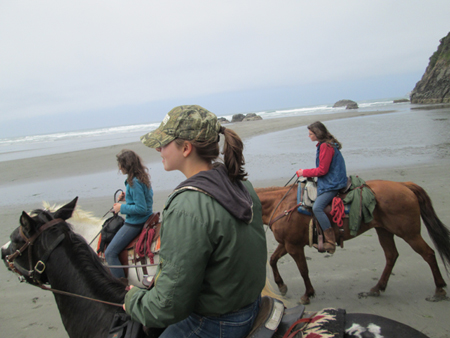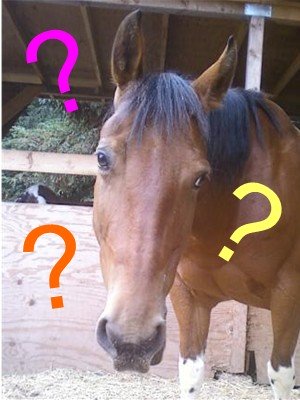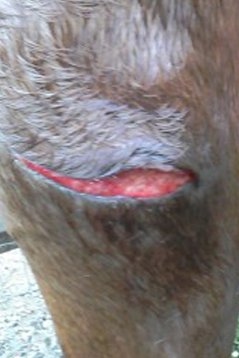How To Stop A Horse
The Essentials for Beginner Riders
Every rider needs to know how to stop a horse, so let’s get started. Horses carry the bulk of their weight on their front legs, while their back legs and rump act as the motor that drives them forward. Horses very much respond to a shift of weight in the saddle. If you have read how to ride a horse, you’ll recall that leaning forward in the saddle is one way of asking for more forward movement and more speed. While shifting your weight to the left or right is another signal for your horse to turn.
How to Stop A Horse – Weight, Hands and Feet
Sending signals to your horse is a full body activity on your part. When you ask a horse to stop, you will be shifting the weight of your body deep into the saddle and back. Keep your shoulders straight and lean back. Visualize your rear end becoming very heavy and sinking right down into the saddle. Your horse will feel this shift in weight. Simultaneously you will also be using your hands and your feet.
With the balls of your feet in the stirrups, bring your feet forward to brace yourself for the stop. Much like the driver of a car would reach out to touch the brakes. With both hands on the rein, pull back toward your belly button. Keep you hands low. Beginners often make the mistake of pulling the reins way up high toward their ears.
 The rider in front has a proper hand position to rein the horse in. Her hands are nice and low. The middle rider has her hands much to high. Pulling the reins toward her chest.
The rider in front has a proper hand position to rein the horse in. Her hands are nice and low. The middle rider has her hands much to high. Pulling the reins toward her chest.When new riders are learning how to stop a horse, they often hold the reins in the wrong place. If your reins are too long, you will have to pull way too much slack. It's not practical or effective when stopping a horse. When you are just riding along, your hands should be about even with the saddle horn, with the reins neither tightly pulling on the horse’s mouth, nor hanging loosely from the bit. You want just enough slack on the rein that your horse can move out freely, but not so much slack that you have to pull miles and miles of rein in to stop your horse!
Remember the golden rule - use the least amount of force needed to get the job done. Never jerk and yank on a horse’s mouth. It is cruel and painful. All horses are different. A well trained cattle working horse will come to a sliding stop with just a shift of the rider’s weight in the saddle. Most horses will need a stronger signal from you, than just a weight shift.
Use a firm but gentle hand to pull on the reins while asking for a stop. If the horse does not respond, increase the pressure on the rein accordingly until they do. Keep your hands low. If you have too much slack in the reins, reach down lower on the rein and pull toward your belly button. Remember to keep your weight shifted back toward the horse’s rump, shoulders back, heels down and feet forward to brace for the stop. Don’t lean forward or let your heels fly up toward the sky. When your horse has come to a complete stop, release the pressure on the rein. That is how to stop a horse.
Horse Riding Tip – Backing Up
At some point you will need to back your horse up. This is how you do it. With your horse at a stand still you are going to ask them to move backwards. Take the reins in both hands. Keeping your hands low, pull back gently but firmly, lean back in the saddle and say the words “Back, back, back,” out loud to your horse. Many horses have learned to respond to these words. Don’t worry if your horse has never learned them, it certainly won’t harm anything in the hearing of it.
It’s kind of like backing up a car. Sometimes you have to make small adjustments with the steering wheel. If the horse tries to turn around instead of backing up, you will need to make small adjustments with the reins, putting more pressure on the left and then right side of the horse’s mouth to get them to back in a straight line. The horse wants to move away from the pressure of the bit in their mouth, so they will back away from it. As soon as you've backed far enough, release the pressure immediately.
How to Stop a Horse From Increasing Speed
Now that you have learned how to stop a horse, you will learn how to slow them down. Horses are herd animals and they like to stay in groups. When you are out horseback riding with a bunch of friends, odds are that not every horse in the bunch will have the same walking speed. Someone on a pony may have to trot frequently just to keep up with the other horses in the group. Sometimes the mere sight of one horse trotting will excite the other horses and they’ll all want to go faster too. Horses tend to be very playful that way. It’s up to the horseback riders to keep it from getting out of hand.
Here's how to stop a horse from speeding up. You will be using the same signals as when you are asking a horse to come to a complete stop. The difference being, your signals will be much more subtle. You will keep your weight at the back of the saddle. Remember, leaning forward means ‘speed up’ to a horse, so lean back and keep your heels down. Take the reins in both hands and pull back. The moment your horse slows her pace, release the pressure. If the horse speeds up again, repeat the process. Do this as many times as it takes to maintain the speed you want.
You will develop a feel for the horse’s mouth. Your hand on the rein is like a dance. You will hold the rein with just the right amount of slack so that you can have gentle contact with the horse’s mouth.
How To Stop A Horse That Jigs
A jiggity horse is one that is excited and refuses to walk….jiggity jogging, bouncing along, and not paying attention to where they place their feet. It doesn't take much before you begin to feel as if you’re slowly being pummeled to death. It’s not very comfortable and is usually rather irritating for the other riders around you. One jiggity horse begets another.
Horse Riding Tip
Put a little extra weight on the balls of your feet, in your forward shifted stirrups. That will take some weight off your butt and offer some relief from the constant pounding of a jiggity horse.
Here's how to stop a horse that jigs. Use all the body signals that you have learned to slow a horse down. Sometimes the horse will slow to a walk. But often you will find that a jiggity horse just jigs slower….this can be very frustrating. That’s when you begin to use what I call the ‘see saw’ technique.
This is not a full proof method by any means, but I have found it to be effective in most cases. Keep in mind that until your horse settles down, you may have to ‘argue’ with them for a bit. Be persistent. It may feel like a ‘battle of the wills’, but it is worth the effort.
With both hands on the rein, pull back until you can feel you have made good contact with the horse’s mouth. Use your fingers to pull the reins alternately left, right, left. This is a very small hand movement. You are not pulling the reins to the left and right as if you want the horse to turn around. You are only using your fingers to pull on the bit, putting pressure on the bars of the horse’s mouth. Left, right, left, right, left. As soon as the horse drops to a walk, release the pressure. This is their reward.
You may have to do this repeatedly until the horse finally gives in and decides to walk. The pressure that you are applying to the horse’s mouth is not very comfortable. The horse eventually figures out that every time they slow to a walk the pressure stops. Since horses prefer comfort over discomfort, they choose to walk.
Once you have mastered the skill of how to stop a horse at a walk, you will be ready to start learning how to stop them at faster speeds. With a little practice, it will become second nature and your body will make all the right moves, with out you even having to think about it!
More Equine Topics You May Enjoy
Horse Buying Guide
Buying a Horse - Sage advise to help you make your first horse purchase with out getting taken advantage of by less than honest sellers.
Camping with Your Horse
Camping with your horse - Learn how to prepare your horse for the trail and the feed.
Beautiful Equine Artwork
Check out these equine paintings by talented artist Cathy Cleveland. Available as note cards, posters and canvas prints.



